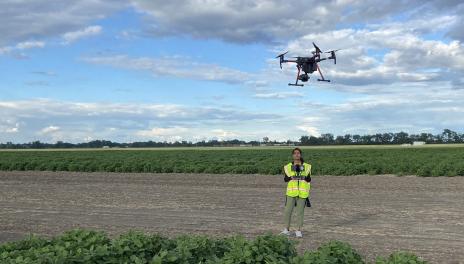NDSU Plant Breeding Programs Using UAVs to Improve Efficiency
North Dakota State University crop breeding programs are of critical importance as they focus on developing improved varieties specifically adapted for North Dakota and surrounding states.
“A released variety combines many of the desirable traits of economic importance for a specific crop,” says Juan Osorno, NDSU dry bean breeder. “However, plant breeding is a multi-year, long-term effort requiring multiple steps including hundreds of crosses annually, evaluations at multiple locations, and selection of superior genetic material. The breeding pipeline can be a cumbersome and tedious effort to find a breeding line with all desired traits. Nonetheless, the contributions of plant breeding to crop productivity are widely demonstrated.”
Plant breeders are constantly looking for methods and tools to improve selection efficiency. Basic genetics, genomics, agronomy, physiology, pathology and entomology, among others, have improved the selection process.
Marker Assisted Selection (MAS), high throughput genotyping and evolving genomic tools allow breeders to track some specific genes of economic importance within the breeding pipeline. The current bottleneck for efficient selection in a breeding program is the need to manually measure all these traits of interest in thousands of lines (and across multiple locations). This is technically known as phenotyping.
With a grant from the North Dakota Agricultural Experiment Station, a multidisciplinary group of NDSU plant breeders, NDSU Agricultural and Biosystems Engineering (ABEN) faculty and graduate students are working on the potential application of precision agriculture tools into their breeding programs.
“In dry beans for example, the goal is to use Unmanned Aerial Vehicles (UAVs) to regularly collect data over breeding trials for traits such as emergence, plant height, canopy closure, days to maturity and foliar diseases, among others,” says Maria de Oliveira, NDSU Department of Plant Sciences graduate student.
“The pea breeding project is testing the utility of a UAV for assessing foliar damage in dry pea caused by Fusarium wilt under field conditions,” says Sai Manogna Adapa, an NDSU ABEN graduate student. “Similar efforts are underway within the potato breeding program, while the soybean program is collecting UAV-obtained data of progeny row canopy closing rates as a predictor of yield.”
In addition, a field robot, driving under the canopy of the crop, is being used to measure traits that are difficult to detect with UAVs such as pod count per plant and stem thickness. Another use for robots is to measure the “under-canopy” temperature in potatoes, which may be correlated with disease incidence.
“Findings of this research may also have application in other agricultural management practices in large-scale crop production, like models based on aerial observations predicting when and where to apply disease management and yield estimates during the season,” says Hans Kandel, NDSU Extension agronomist.
Data from multiple locations and years will be needed to develop robust prediction algorithms.
FOR MORE INFORMATION:
Juan Osorno, 701-231-8145, juan.osorno@ndsu.edu
Hans Kandel, 701-231-8135, hans.kandel@ndsu.edu
